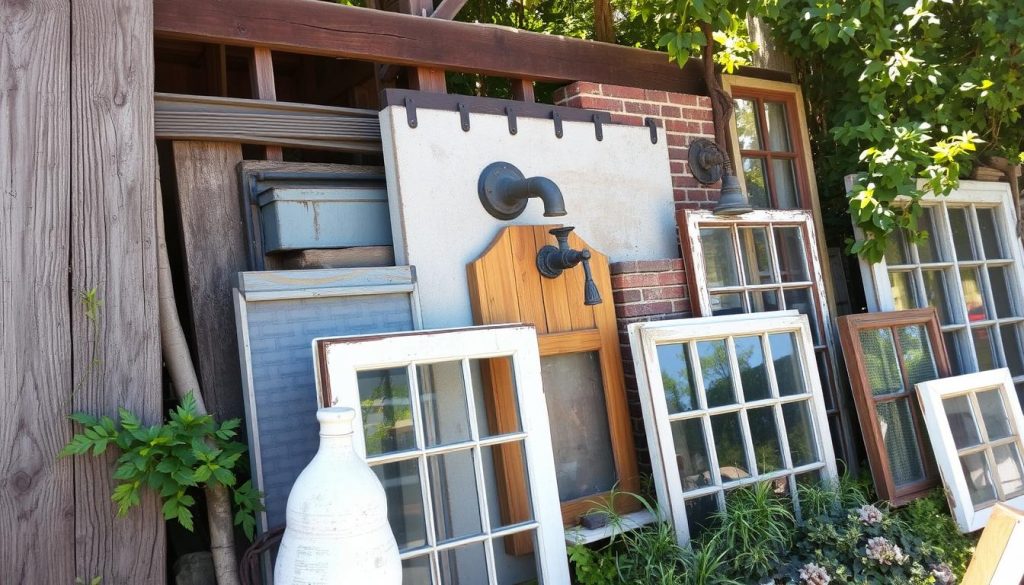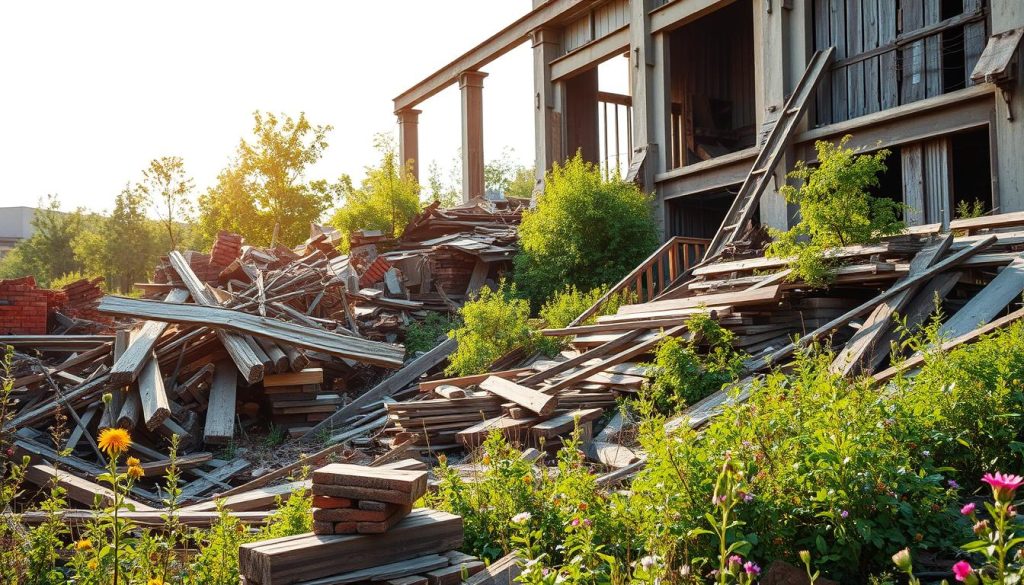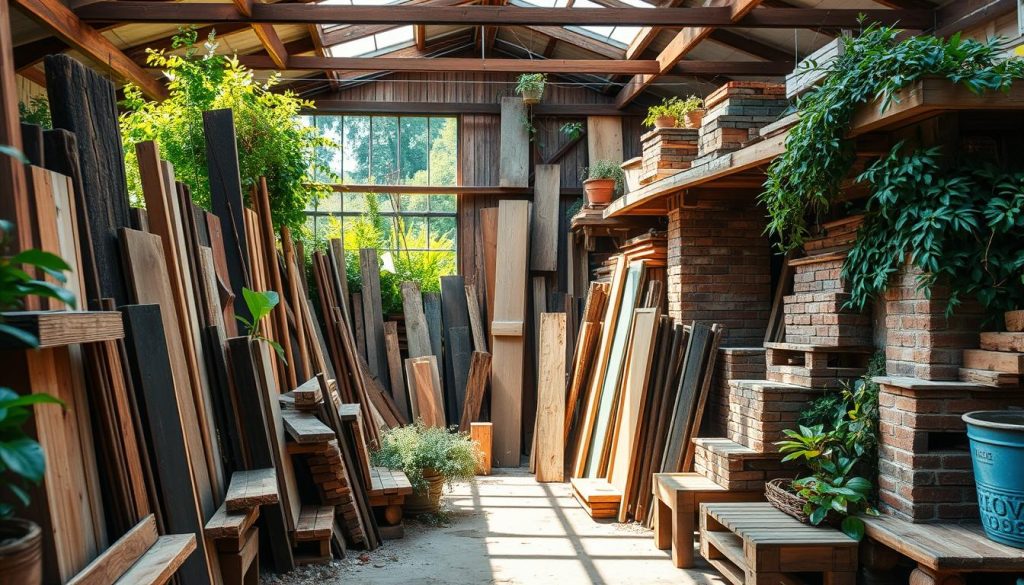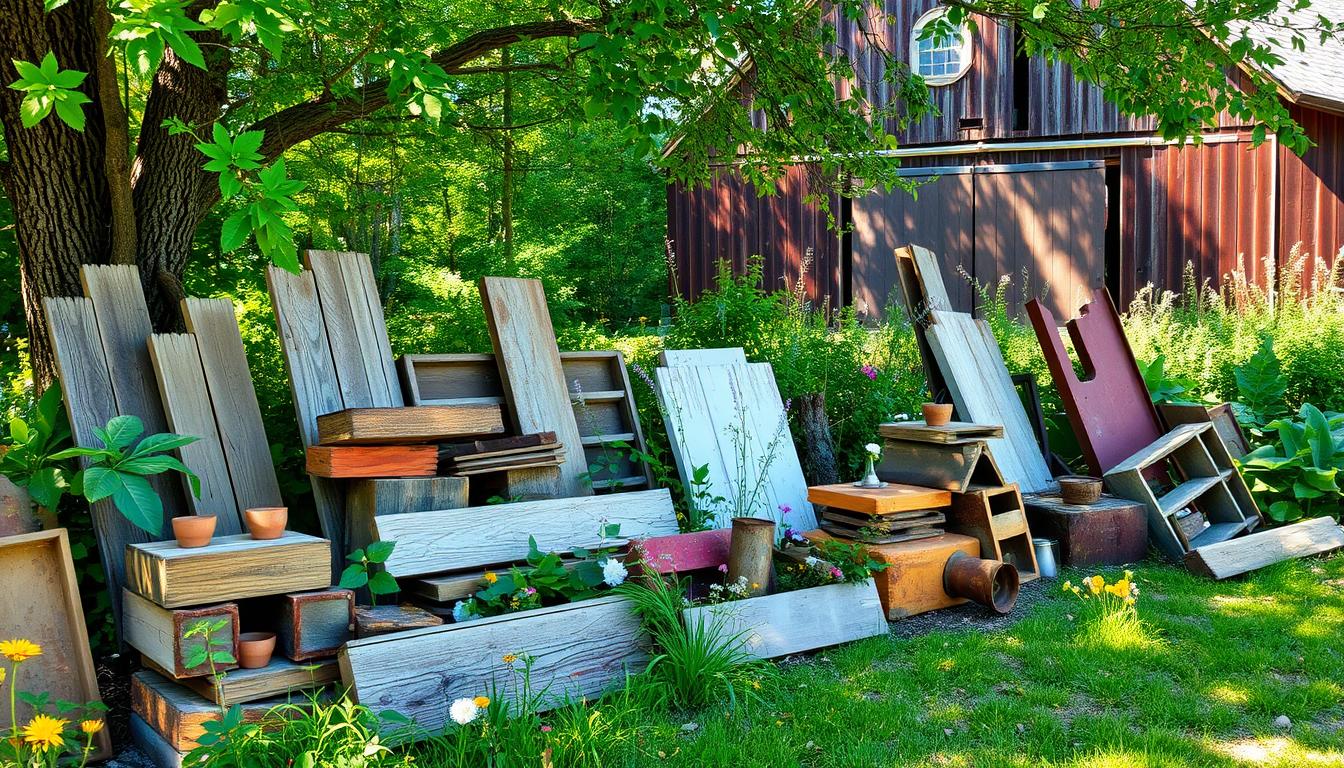I’m excited to share my knowledge on salvaging building supplies. This guide will show you the benefits of using reclaimed materials. You’ll learn how to find and use these materials in your projects.
Salvaging materials is good for the planet and your wallet. It helps reduce waste and saves money. Let’s explore how to find and use these treasures in your projects.
Why Salvaging Building Supplies is Important
Salvaging building supplies is key to reducing our environmental impact. It supports green deconstruction and architectural salvage. These practices save money and help the planet.
The Environmental Benefits of Salvaging
Salvaging materials keeps them out of landfills. This cuts down on waste and saves natural resources. It’s a step towards a greener future.
Reducing Landfill Waste
- Divert valuable materials from landfills
- Conserve natural resources
- Minimize the environmental impact of construction and demolition
Saving Money on Building Projects
Salvaging also saves you money. You can find quality, used items at lower costs. This lets you spend more on sustainable solutions.
Architectural salvage and urban mining are smart, green choices. They help us build sustainably and save on costs.
How to Identify Salvageable Materials

Identifying materials to reuse is key in repurposing construction materials. As a DIY fan and sustainability advocate, I’ve learned to spot valuable items in the trash. Let’s look at common building materials that can be reused and how to check their condition.
Common Building Materials to Salvage
- Solid wood planks, beams, and trim
- Reclaimed bricks, stones, and concrete blocks
- Functional doors, windows, and hardware
- Ceramic tiles, hardwood flooring, and linoleum
- Copper pipes, light fixtures, and other metal components
Tips for Assessing Condition and Quality
Checking the condition and quality of materials is vital. Here are some tips I’ve found helpful:
- Inspect each item for damage, wear, and structural integrity.
- Test moving parts, like hinges and locks.
- Check if repairs or modifications are needed.
- Consider the material’s age, origin, and past use.
- Compare the quality of salvaged items to new ones.
By carefully assessing materials, you can ensure they fit your project needs. Using recycled materials is a smart, sustainable choice for construction and renovation.
Where to Find Salvageable Supplies

I love finding top-quality salvageable building materials. There are many places to look, from local reuse centers to online marketplaces. You can also join social media groups to find hidden gems for your projects.
Local Reuse Centers and Salvage Yards
Start by visiting local reuse centers and salvage yards. They have a lot of reclaimed materials. You can find things like antique hardwood flooring and unique light fixtures at lower prices.
Online Marketplaces and Social Media Groups
The internet is full of opportunities to find salvageable materials. Sites like Craigslist and Facebook Marketplace are great for finding deals. You can also join local Buy Nothing groups to find materials.
Networking with Builders and Contractors
Talking to local builders and contractors can also help. They often have materials from job sites they can give away. Building relationships can lead to finding quality salvaged supplies and helping the environment.
Techniques for Salvaging Building Supplies

I’m passionate about sustainable salvage and green deconstruction. I’ve learned many ways to get valuable materials from old buildings. I’ll share my top tips on tools and safe practices to help you make the most of your salvage.
Tools I Use for Effective Salvaging
Having the right tools is key for successful salvage. Here are the essentials I always use:
- Heavy-duty pry bars for carefully removing nails and dismantling structures
- Angle grinders with various cutting discs for precision deconstruction
- Oscillating multi-tools for accessing tight spaces and delicate components
- Dust masks and protective eyewear to ensure a safe work environment
Safe Dismantling Practices
Safety is the top priority in salvage work. I follow these best practices to stay safe:
- Thoroughly inspect the structure for any potential hazards, such as asbestos or lead-based paint, before beginning the salvage process.
- Wear appropriate personal protective equipment (PPE), including gloves, hard hats, and steel-toed boots, to safeguard against injuries.
- Use caution when dismantling load-bearing elements, carefully supporting the structure to prevent unexpected collapses.
- Employ proper lifting techniques and enlist the help of additional hands to move heavy or awkward materials.
Documenting My Salvaged Assets
Keeping good records is crucial for my salvage work. I document every item I find, including its condition and uses. This helps me plan future projects and reuse materials efficiently.
Creative Ways to Use Salvaged Materials
Exploring the potential of reclaimed building supplies is thrilling. It ranges from DIY projects that bring rustic charm to your home to advanced renovation ideas. These ideas highlight the beauty of repurposed materials, offering endless possibilities.
DIY Projects to Try at Home
Get creative with salvaged wood, bricks, or metal to decorate your home. Turn an old barn door into a unique coffee table or make a wall hanging from reclaimed barn wood. Even simple tasks like making mirrors or picture frames from salvaged windows can enhance your space.
Incorporating Salvaged Materials in Renovations
Salvaged materials truly come alive in big renovation projects. Use old barn beams as supports for your kitchen island or create a fireplace surround with reclaimed brick. Antique doors and windows can become stylish room dividers or decorative pieces. Your imagination is the only limit.
Inspiring Examples from Fellow Salvagers
Across the country, dedicated salvagers are turning reclaimed materials into stunning pieces. They’ve made everything from cozy farmhouse kitchens with barn wood cabinets to modern bathrooms with vanity from old industrial workbenches. Their creativity and skill inspire me to keep exploring salvaged building supplies.

